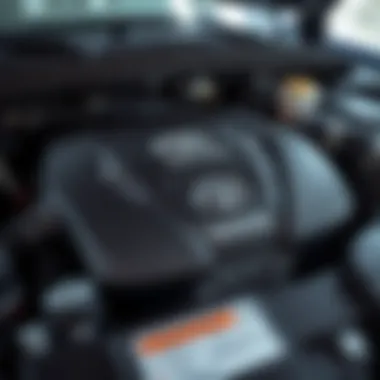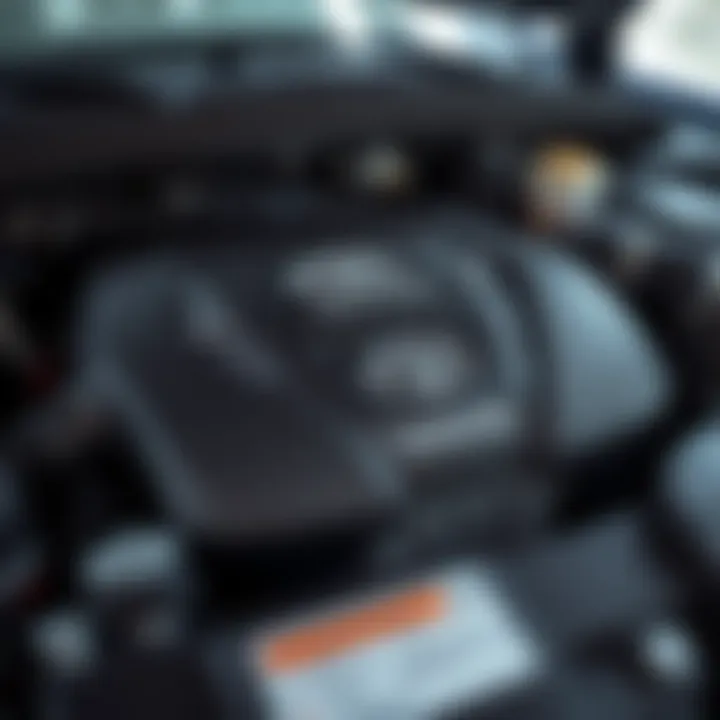In-Depth Look at the 2012 Toyota Tundra 4x4


Intro
When it comes to full-size pickup trucks, few can claim the robust reputation and reliability that the Toyota Tundra has established over the years. The 2012 Toyota Tundra 4x4 stands as a prime example of the brand's commitment to durability and performance in rough-and-tumble conditions. As truck enthusiasts know, this isn't just a vehicle for hauling lumber or towing trailers—it's a multi-faceted workhorse that's equally at home on the job site and at the weekend getaway.
As we journey through this exploration, we’ll peel back the layers of the Tundra's construction—from its key specifications to how it holds up in real-world applications. Whether you're in the market for a beefy truck or simply a fan of automotive engineering, this deep dive will shed light on both the strengths and limitations of the 2012 model.
Make no mistake, there’s a lot riding on your next truck purchase. Between the competition and evolving consumer expectations, knowing the ins and outs of this model can help you make an informed decision. So, let’s buckle up and embark on this comprehensive examination of the 2012 Toyota Tundra 4x4.
Foreword to the Tundra 4x4
The 2012 Toyota Tundra 4x4 holds a notable place in the truck world. It stands at the intersection of reliability and performance, striving to address the diverse needs of truck enthusiasts and everyday users. As the full-size truck segment has seen its share of heavy hitters, understanding where the Tundra fits within this landscape is essential for potential buyers looking for versatility and robustness. This introduction aims to unpack the significance of the 2012 model, reflecting on key aspects that distinguish it in a crowded marketplace.
Significance in the Full-Size Truck Class
The full-size truck class is often viewed as a conglomeration of power and functionality. The 2012 Tundra is significant for its steadfast reputation, which speaks volumes to consumers seeking vehicles that can handle tough jobs while providing comfort. It communicates resilience and a can-do attitude, able to haul heavy loads and navigate rugged terrains, making it not just a vehicle, but a trusted partner for both work and play.
In various reviews and performance tests, the Tundra continually garners praise for its towing capabilities and off-road prowess. It enjoys a loyal following among those who appreciate traditional V8 engines that offer a commanding road presence. Therefore, an in-depth exploration of the Tundra’s various attributes reveals not only its engineering strength but also how it performs in real-world scenarios. This is critical for anyone contemplating their next vehicle choice.
Target Audience and Market Positioning
Understanding the target audience for the 2012 Tundra 4x4 provides key insights into its design and functionality. The Tundra appeals largely to individuals who appreciate the blend of comfort, durability, and advanced features. Think of construction workers who need a reliable machine, or outdoor enthusiasts looking for a truck that can carry gear without breaking a sweat.
The Tundra finds itself a deserving contender in a marketplace where competition is fierce. Buyers may also include families needing extra space for kids and cargo. Its roomy interiors and diverse cab configurations reflect Toyota’s awareness of a wide range of demands.
The market positioning of the Tundra does not solely revolve around utility, but extends to providing a sense of security and confidence. As much as it is about function, it's also about the peace of mind knowing you're driving a truck built to last.
Therefore, this introduction sets the stage for a more detailed examination of the Tundra’s performance characteristics, interior features, and overall consumer reception. These aspects are crucial for anyone who’s considering investing in a truck that is more than a simple means of transportation.
Performance Characteristics
Understanding the performance characteristics of the 2012 Toyota Tundra 4x4 is fundamental for both enthusiasts and potential buyers. The performance metrics not only showcase the vehicle's capabilities on the road and off but also reveal its reliability, efficiency, and overall driver satisfaction. In an era where trucks are not just tools but a lifestyle choice, dissecting these characteristics can greatly inform a purchasing decision.
Engine Options and Specifications
V8 Engine Overview
The heart of the Tundra lies in its engine options — two formidable V8 engines that make the truck stand out in a crowded market. One is a 4.6-liter, while the other is a more powerful 5.7-liter. The key characteristic is their robust power output, reaching up to 381 horsepower with the larger option, which translates to a thrilling driving experience.
This V8 concoction isn’t just about raw power. The 5.7-liter variant is known for smooth acceleration, which is crucial when it's loaded down or tackling steep grades. A unique feature of this engine is its capability to operate efficiently even under heavy loads, making it a popular choice among those who tow or haul frequently. However, high power often comes with a price at the pump, as fuel consumption can be a downside when compared to smaller engine alternatives.
Fuel Efficiency Ratings
Fuel efficiency is another crucial aspect of the Tundra's performance characteristics. With ratings that hover around 13 to 18 miles per gallon, the Tundra isn't leading the pack in this category. However, it's essential to consider the trade-off between power and efficiency. The Tundra's robust engines deliver performance that enthusiasts crave, but it does come at the cost of fuel economy. It’s not the best choice for those who prioritize efficiency alone.
However, the Tundra's engine management system does include features aimed at optimizing fuel consumption, particularly in the 5.7-liter variant. This doesn’t mean it’s a green machine by any stretch, but knowing how to utilize these features can lead to a more balanced driving experience.
Performance Metrics
Performance metrics reflect the Tundra's capability to handle various drive conditions effectively. Acceleration from 0 to 60 mph is achieved in approximately 6.6 seconds with the 5.7-liter engine, which is respectable for a full-size truck. Its towing capacity reaches up to 10,400 pounds, making it a serious contender in the competitive towing game.
What sets these metrics apart are the truck’s versatility in both urban and off-road environments. The robust design offers a comfortable ride on highways, while still being rugged enough for off-road adventures. This adaptability is one of the Tundra's most appealing characteristics; however, potential buyers should evaluate whether they truly need such capabilities since it may come with a weight penalty in agility compared to lighter trucks.
Handling and Off-Road Capability
Suspension System Overview
The suspension system in the Tundra is engineered to balance comfort and capability. Featuring a double-wishbone front suspension and a solid rear axle, it provides a blend of stability and agility. The system is crucial for maintaining ride quality without sacrificing off-road performance.
One of the notable advantages is its ability to absorb bumps and rough terrains, which many owners have lauded. While this aids in providing a pleasant ride even on rugged conditions, the trade-off is that it may not handle tight cornering as well as some of its competitors.
4x4 System Operation
The 4x4 system in the Tundra focuses on delivering predictable and reliable power to all four wheels. It employs a part-time four-wheel drive system, allowing drivers to switch to 2WD when not needed, which can save on fuel in daily driving. This system's standout feature is its responsiveness in adverse conditions, be it mud, snow, or slippery surfaces.
While the engaging of the 4x4 system is straightforward, some users report that it can take a moment to switch, which can be a little inconvenient in quick-changing conditions. However, when engaged, it presents a level of confidence that assures the driver, making it a considerable option for those often venturing off the beaten path.
Towing Capacity Insights
The towing capacity of the Tundra is one of its defining traits. With capacity figures peaking at 10,400 pounds, it stands as a powerful choice for anyone needing to transport heavy loads. This capability is not merely a number; it reflects the Tundra's robust construction and engine performance working in tandem.
Many users have successfully towed trailers, boats, or heavy equipment without struggle, emphasizing its reliability in demanding situations. However, it’s paramount to consider additional equipment for optimal towing, like brake controllers or mirrors, to enhance safety during the towing experience. Buyers should fully understand their towing needs to leverage the Tundra's strengths effectively.
In summary, the 2012 Tundra 4x4 checks critical boxes in performance — from strong engine options to robust towing and off-road capabilities. For those in need of a truck that excels across various terrains, it holds a strong position.
Interior and Comfort Features


When it comes to picking a full-size truck, the interior and comfort features are far from an afterthought. For many buyers, these elements can be as essential as the vehicle’s performance stats. The 2012 Tundra 4x4's cabin isn’t just built for looks; it’s crafted for functionality and ease of use. Let’s dig into what makes the interior stand out.
Cab Options and Layouts
Regular, Double, and CrewMax Variants
The 2012 Tundra offers three cab configurations: Regular, Double, and CrewMax. Each variant serves a distinct purpose and fits different needs, essentially catering to a wide audience.
- Regular Cab: This one is great if you’re all about utility. It provides just enough room for work essentials and a buddy beside you. The straightforward design makes it a favored choice among tradespeople and those who only need a truck for day-to-day tasks. However, if you’re looking to haul more people, it might feel a bit cramped.
- Double Cab: The middle ground here, this variant goes a long way in providing extra rear seating, which makes it perfect for family trips or carpooling. That additional room can be a godsend, especially when you’ve got the kids and their gear.
- CrewMax: Known for its spaciousness and comfort, this version is all about the luxury experience. With back seats that rival many SUVs, it’s a popular pick for anyone who wants to balance work and play without feeling squished. However, the turning radius is not as tight as some might like, especially in urban settings.
Space and Comfort Analysis
Cab configuration aside, let's focus on space and overall comfort. The 2012 Tundra puts a premium on interior dimensions, giving ample legroom and headspace across all cab options.
- Legroom: No one likes to feel suffocated in a vehicle, and the Tundra does well to prevent that feeling. Passengers in the backseat of the Double and CrewMax variants can stretch their legs without feeling as if they are at a summer camp.
- Seating Comfort: The Tundra has seats that are cushy and supportive, perfect for long drives. Even after hours behind the wheel, you’re less likely to feel like you've been through a meat grinder.
Overall, the emphasis on spaciousness forms a compelling aspect of the buying decision for many.
Plenty of interior features, like adjustable seat positions and available leather upholstery, contribute to the overall experience. However, keep in mind, the plush finish can sometimes be at odds with utilitarian purposes, such as heavy-duty hauling.
Technology and Infotainment
A modern truck needs to keep up with tech demands, and the 2012 Tundra doesn’t disappoint with its infotainment options. This segment is critical for buyers who value in-cabin technology as much as engine specs.
Audio Systems
The Tundra offers several audio systems, ranging from basic setups to more advanced ones. The base models come with a decent sound system for casual listeners, but the top-tier options get you sound quality that can really turn heads.
- Key Feature: Some models have a JBL audio system that’s almost concert-worthy, making it an outstanding choice for anyone who wants to enjoy music on the go.
- Disadvantage: However, some users have reported connectivity hiccups, especially with older devices.
Navigation Options
Using the Tundra can mean hitting the road in various directions, and a solid navigation system can turn those travels into a breeze. The 2012 model has navigation features designed to help you find your way easily.
- Key Feature: The navigation system is user-friendly and can provide real-time traffic updates. It’s more than just a map; it often saves time.
- Disadvantage: On the flip side, updates may require extra costs, which can add up over time.
Bluetooth Connectivity
In a world of smartphones and streaming, Bluetooth Connectivity has become a must-have. The Tundra allows for seamless pairing with devices, which is a major benefit for many.
- Key Feature: Once you're paired, making calls and streaming music is smooth. This keeps the focus on the road while keeping you connected.
- Disadvantage: A few users have mentioned occasional drops in the connection, which can be annoying during crucial calls.
In summation, the interior and comfort features of the 2012 Toyota Tundra 4x4 create a compelling case for those in the market for a full-size truck. From versatile cab layouts to infotainment technology, the thoughtfulness of these elements enhances both everyday usability and enjoyment.
Safety Features and Ratings
When considering a vehicle like the 2012 Toyota Tundra 4x4, safety features and ratings emerge as pivotal aspects. In the full-size truck market, where sheer size can sometimes obscure safety, understanding what protective measures are in place is crucial for potential buyers. The Tundra 4x4, noted for its robust build, brings a suite of safety equipment designed to bolster protection for both driver and passengers. In an era where accidents are ever-present, equipping a truck like the Tundra with advanced safety features is not just a benefit; it’s a necessity.
Standard Safety Equipment
Airbag System Overview
The airbag system in the Tundra 4x4 includes front, side, and curtain airbags, ensuring comprehensive coverage during an impact. This multifaceted approach to airbag deployment significantly enhances occupant protection. One key characteristic of this system is the inclusion of dual-stage airbags, which deploy with varying force based on the severity of the crash. This adaptability is a pivotal feature, as it allows for inflated bags tailored to each unique collision scenario. Overall, the airbag system adds a layer of reassurance behind the wheel, making it a celebrated element in safety discussions of the Tundra.
However, as with any feature, there are drawbacks. While the Tundra's airbags provide extensive coverage, their effectiveness can greatly rely on proper seatbelt usage. An airbag without a seatbelt can be a bit like wearing a raincoat without a hat; it may protect you, but not completely.
Electronic Stability Control
Electronic Stability Control (ESC) is a game changer when it comes to vehicle safety. The Tundra’s ESC works tirelessly in the background, monitoring and adjusting the vehicle’s traction and direction. This system is particularly beneficial during adverse weather conditions or sudden maneuvering, as it can help prevent rollovers and skids.
A standout characteristic of this system is its proactive engagement; when it senses a loss of control, it automatically applies brakes to individual wheels, correcting the direction of travel. This feature makes the Tundra not just a truck, but a dependable partner on and off the roads. However, the reliance on such technology may lead some drivers to feel overconfident, potentially encouraging riskier driving behaviors. Nevertheless, the advantages of having ESC cannot be overstated—it significantly enhances confidence during tricky maneuvering.
Crash Test Ratings
NHTSA and IIHS Performance
When it comes to safety, the independent evaluations from organizations like the National Highway Traffic Safety Administration (NHTSA) and the Insurance Institute for Highway Safety (IIHS) are invaluable. For the 2012 Tundra, both institutes rated it favorably, citing its solid structure and safety features. NHTSA gave the Tundra a five-star overall rating, which reflects a strong performance in crash tests, particularly in front and side impact tests.
This top rating is not just a number; it’s a testament to the engineering behind the truck's design. Customers appreciate not just numbers but the confidence that comes with knowing their vehicle can withstand impacts effectively. There is always the note, however, that ratings can change with newer models being released, prompting consumers to continually assess how their vehicle stacks up against the competition.
Key Rating Factors
Several factors are key when evaluating crash test ratings, including structural integrity, airbag effectiveness, and the vehicle's ability to protect passengers during a crash. The Tundra's robust framework, combined with its predictable handling, enhances its safety profile significantly. A noteworthy aspect of the ratings process is how well these vehicles perform in real-world scenarios, which are often more unpredictable than a controlled crash test environment.
This reality can skew perceptions of safety, as a favorable rating does not guarantee absolute protection. Prospective buyers should weigh these ratings against personal habits and driving environments. While high ratings add a layer of safety reassurance, they remain just one piece of the broader safety puzzle.


Design Attributes and Aesthetics
When exploring the 2012 Tundra 4x4, the design attributes and aesthetics are vital components that blend functionality with visual appeal, capturing the attention of potential buyers. This aspect not only propels the trucking experience but also solidifies the Tundra’s presence in a competitive market. Well thought-out design can make all the difference in utility and attractiveness, ensuring that it stands out among rivals.
Exterior Design Choices
Front-end Styling
The front-end styling of the Tundra serves as its initial handshake with onlookers and potential buyers. This feature incorporates a bold grille design, which is a hallmark of the Tundra. The prominent chrome accents, paired with well-defined headlights, create an assertive visage that projects strength and confidence. This decision to adopt a hefty front styling resonates well in the full-size truck landscape; it doesn't shy away from being declared tough.
One might argue its design adds visual weight, making it a solid choice. A significant aspect here is the aerodynamics; although trucks are not typically lauded for this attribute, the Tundra’s front-end elements help reduce drag, which can enhance fuel efficiency over long distances. However, some buyers might find this heavy aesthetic slightly off-putting if they prefer a more streamlined look.
Tailgate Design
The tailgate design of the Tundra contributes to both utility and aesthetic charm. A standout feature is the integrated tailgate assist, which allows for smooth and controlled opening, a simple yet practical amenity for users frequently loading or unloading cargo. This ease can’t be overstated—imagine you’re at a job site; juggling tools and supplies becomes a tad easier when you don't have to wrestle with your tailgate.
Moreover, the Tundra offers a customizable tailgate with optional features such as an easy lower and lift system, reinforcing its reputation for user-friendly functionality. A drawback, however, might be the tailgate’s weight; it could feel a bit cumbersome for some individuals who might prefer a lighter setup. Yet overall, the design remains a balance of form and function.
Color Options
Color options play a crucial role in the aesthetic appeal of the Tundra. The 2012 model offers a variety of shades ranging from bold metallic blues to understated earth tones. A key characteristic is the availability of vibrant alternatives such as Inferno Orange, which can be particularly appealing to those looking to distinguish their truck from the conventional crowd.
Furthermore, the paint quality and finish are noteworthy, designed to resist chipping and fading over time. Durability is often a selling point for truck enthusiasts, who know that their vehicle will withstand the elements while maintaining its looks. That said, more traditional buyers might gravitate towards subtler colors if they're not seeking attention.
Interior Materials and Finishes
Quality of Materials
The quality of materials inside the Tundra reinforces the notion of durability and refinement. When you step inside, you’re greeted with a careful selection of textures and finishes, from soft-touch surfaces to robust plastics that stand up to daily wear and tear. This consideration is vital for truck owners who often utilize their vehicles for rugged purposes while desiring a hint of luxury.
For instance, the well-stitched upholstery options showcase attention to detail, contributing positively to the overall driving experience. Conversely, some might note that certain lower-grade materials could detract from what’s otherwise a premium feel. Nonetheless, it remains an admirable balance between toughness and comfort.
Ergonomic Considerations
Stellar ergonomic considerations in the Tundra's interior make driving long distances a manageable task. Features include adjustable seating and user-friendly controls, ensuring that both the driver and passengers remain comfortable. The design focuses on making frequently used elements, such as the gear stick and multimedia system, easily accessible.
A notable advantage is the spaciousness; it feels open and unconfined, enabling occupants to stretch without risking discomfort. However, it’s important to mention that while the layout is intuitive, some users might have personal preferences that clash with Toyota's design philosophy, affecting their comfort levels. Still, overall, the ergonomics serve to enhance usability, making daily commutes and trips out of town far easier.
Consumer Reception and Reviews
The reception of the 2012 Toyota Tundra 4x4 plays a pivotal role in understanding its standing in a highly competitive market. This section delves into the feedback from users and industry experts, shedding light on how the Tundra is perceived in terms of its performance, reliability, and overall value. It's important to unpack this feedback, as it not only reflects consumer satisfaction but also influences potential buyers and their decision-making processes.
Market Feedback Analysis
When looking at the market feedback for the 2012 Tundra, one often sees a mix of positive and critical reviews. Enthusiasts praise its robust performance and dependability, usually pointing to the powerful V8 engine options that deliver strong towing capabilities. Moreover, users appreciate the spacious interior, which makes it a family-friendly choice for those needing utility without compromising comfort. A common sentiment among Tundra owners is that it withstands both daily driving and rugged terrains with ease.
On the flip side, critiques often arise in discussions surrounding fuel economy. Owners express disappointment with its gas mileage when compared to rivals like the Ford F-150 and Chevy Silverado. Many find that while the Tundra excels in power, its thirst for fuel dampens its overall appeal, especially for those focused on efficiency.
Overall, market feedback reveals that the Tundra earns high marks for ruggedness and capability, yet falls short in efficiency, leaving buyers with a crucial decision to weigh performance against long-term fuel costs.
Comparative Insight with Competitors
Chevy Silverado Comparison
The Chevy Silverado remains a fierce competitor to the Toyota Tundra, especially when considering serviceability and a broad range of trims. Silverado owners often highlight its superior payload capacity, which appeals to contractors and outdoor enthusiasts alike. One striking feature is its available integrated trailer brake controller, which simplifies towing. Additionally, the Silverado boasts a slightly better fuel economy than the Tundra, an alluring characteristic for those who make longer trips or need a reliable workhorse.
However, while the Silverado offers a notable range of tech features and a cozy interior, some users criticize it for inconsistent quality control in certain model years. This feedback may lead prospective buyers to pause and evaluate their options closely.
Ford F-150 Insights
The Ford F-150 has been the top dog in the full-size truck market for years, and it competes effectively with the Tundra in areas like technology integration and trims available. Users frequently mention the easy-to-use infotainment system as a significant advantage in their driving experience. The Tundra's competitors, especially the F-150, provide features like adaptive cruise control and a variety of cab sizes that appeal to both city drivers and those needing ample cargo space.
Moreover, Ford's effective marketing strategies and customer reach give the F-150 a distinct edge. One unique aspect of the F-150 is its EcoBoost engine, which offers impressive power while improving fuel efficiency— a critical consideration for many buyers today.
In contrast, some consumers observe that the F-150 may not match the Tundra in rugged off-road setups. Customers who prefer off-roading often lean towards Tundra, where the specialized trims boast better off-road features straight from the factory.
Ultimately, evaluating customer feedback and comparing it to competitors like the Chevy Silverado and Ford F-150 brings to light the Tundra’s strengths and weaknesses, assisting potential buyers in making an informed decision.
Long-Term Ownership Considerations
When discussing the 2012 Toyota Tundra 4x4, it's essential to focus on the long-term ownership aspects. Buying a vehicle is not merely about the initial purchase; it also includes maintenance, reliability, and future resale value. These elements significantly influence the satisfaction of truck owners over time. If you're considering getting a Tundra, understanding these aspects could potentially save you a heap of cash and frustration.
Maintenance and Reliability
Typical Maintenance Costs


Maintaining a 2012 Tundra involves certain predictable expenses. Generally, the maintenance costs are moderate for a full-size truck, mainly due to the robust engineering Toyota is known for. Owners often report spending between $500 to $700 annually on routine maintenance. This cost typically includes oil changes, brake inspections, tire rotations, and fluid replacements. One worth mentioning characteristic here is the vehicle's reliability, which aligns closely with lower maintenance costs. This reliability ensures that owners are not frequently visiting the mechanic, contributing to a more enjoyable ownership experience.
A unique feature of these costs lies in the ease of availability for parts. Since the Tundra is a popular model, parts are readily available and affordable compared to lesser-known brands. However, it's essential to avoid too much reliance on do-it-yourself repairs for major issues, like transmission troubles, as this could potentially become an expensive endeavor.
Common Issues Reported
When discussing common issues, it’s important to highlight a few specifics. The 2012 Tundra has received reports of brake pad wear that some owners found disappointing, leading to replacements earlier than expected. Another notable issue involves the front suspension, particularly bushings that can wear out swiftly. However, these problems aren’t considered deal-breakers; most Tundra owners feel these issues are relatively minor and manageable.
Additionally, many owners appreciate the vehicle's straightforward mechanics, which can make it simpler for individual troubleshooting. Still, it might be prudent for prospective buyers to be aware of these reports. Having prior knowledge of potential issues could help in making an informed purchase decision, allowing for more confidence in long-term ownership.
Resale Value Prospects
Market Trends
Resale value is a hot topic among truck owners. The market trends surrounding full-size pickups, particularly the Tundra, indicate that these vehicles tend to hold their value better than many rival brands. Current estimates show that a Tundra can retain around 60% of its original value after five years, a hallmark of its reliability and brand appeal. One key characteristic that benefits resale is its reputation for durability. The Tundra’s reliability contributes positively to buyer confidence in used models.
Another appealing aspect is that the demand for full-size trucks remains consistently high. Given this demand, Tundra owners often find themselves in a favorable position if they choose to sell or trade-in their trucks in the future.
Factors Affecting Resale
Several factors come into play regarding resale value. Mileage is among the most significant; fewer miles usually translate to a better resale price. Also, the truck's maintenance history plays a crucial role. A well-documented record of regular service can elevate a Tundra's value on the used market. Moreover, the trim level and additional features affect resale; trucks with higher trims typically fetch a better price.
A unique consideration comes into play with brand loyalty. Many Toyota owners are repeat customers due to their positive experiences, which can keep resale values maintained. Conversely, an owner who faces significant issues during ownership may affect resale negatively. It’s worth taking all these factors into account when evaluating long-term ownership with the 2012 Tundra.
Overall, understanding the nuances of maintenance, reliability, and resale value can aid potential buyers in making a smart purchase decision. The Tundra's standing in these areas speaks volumes about what to expect during ownership.
"A truck is not just a means of transport, it’s part of the family, and the Tundra gets it right."
For further reading on vehicle ownership trends, visit Edmunds or check out insights on Consumer Reports to enrich your understanding of the vehicle market.
Technological Advancements in the Model
In the competitive landscape of full-size trucks, the 2012 Toyota Tundra 4x4 kept pace with changing consumer expectations through various technological enhancements. Advancements in this model were not just bells and whistles; they represented functional improvements designed to elevate the driving experience while maintaining simplicity. This section highlights key innovative features and their impact on an owner’s interaction with the vehicle.
Innovative Features Introduced
Smart Key System
The Smart Key System was a significant introduction in the 2012 Tundra, allowing drivers to unlock and start their truck without removing the key fob from their pocket or bag. This aspect adds a layer of convenience that resonates well with today’s fast-paced lifestyle. One key characteristic of this system is the proximity sensing, which engages with the vehicle as the driver approaches.
This feature simplifies access, particularly when hands are full or during adverse weather conditions. However, some users might note the occasional hiccup, where the system requires close proximity to function effectively. On the whole, the Smart Key System enhances usability while reinforcing Toyota's focus on user-friendly technology.
Enhanced Safety Tech
Another notable advancement was the Enhanced Safety Tech included in the Tundra. Elements like electronic stability control and enhanced braking systems have become vital in improving overall safety ratings for the truck. The central characteristic of these safety features is to assist in maintaining control of the vehicle, particularly in slippery conditions.
While owners often praise this safety enhancement for providing peace of mind, it is important to consider the additional costs associated with maintaining such advanced systems. Overall, the Enhanced Safety Tech not only provides a layer of security but establishes the Tundra as a trustworthy option in its category.
Impact on Driving Experience
User Interaction
When discussing driving experiences, user interaction stands heavily at the forefront. The incorporation of digital interface systems in the 2012 Tundra enhances driver engagement, making it easier to access navigation, multimedia, and connectivity features. The user-friendly setup allows for a smoother transition between driving and interacting with technology.
Though certain critics argue that this tech can be more distracting than beneficial, Toyota aimed to ensure a balanced approach to user experience. Thus, one could say that the user interaction aspect of the Tundra brings innovative tech to the driving realm while demanding responsible engagement from the driver.
Real-World Usability
Lastly, real-world usability defines how well these technological advancements translate into day-to-day driving scenarios. Drivers have expressed appreciation for the ergonomic layouts that place controls within easy reach and enhance comfort during long drives. This is complemented by the ability to customize settings according to personal preferences.
However, users have pointed out that the sheer number of options can sometimes be overwhelming for those less tech-savvy. Despite this, the real-world usability of the 2012 Tundra illustrates a successful blending of modern tech with practical application, catering to both seasoned truck owners and new buyers alike.
Finale: Evaluating the Tundra's Legacy
The 2012 Toyota Tundra 4x4 stands as a remarkable figure in the full-size pickup truck arena. As this articlel has explored, the Tundra’s attributes frame it not just as a vehicle, but as a versatile tool for both work and leisure. Shifting gears from performance specs to consumer sentiments, one can see its resilience in the competitive landscape of trucks.
Overall Assessment
When casting an eye over the Tundra, it’s clear that it shines in several areas. The robust V8 engines provide a hefty punch, which speaks volumes about its reliability and power on the road. Many owners have consistently praised the Tundra for its towing capacity, finding it loyal whether they’re hauling a heavy trailer or loading gear for a camping trip. Moreover, the various cab sizes cater to a broad audience, from families to trademen needing space.
However, drawbacks have emerged as well. While fuel efficiency isn't a highlight, many consider the trade-offs reasonable given the Tundra's performance capabilities. Interior aesthetics may not rival those of some more premium competitors, yet the utilitarian design serves a clear purpose.
"The Tundra continues to be a strong contender, balancing performance with everyday practicality." - Truck Expert
The Future of the Tundra Line
As we look ahead, the future of the Tundra line carries intrigue and potential shifts. Consumer expectations are evolving, leaning towards increased fuel efficiency and advanced technology. This could influence Toyota's trajectory in upcoming models, perhaps necessitating reimaginings of powertrains and onboard features.
Toyota has hinted at incorporating hybrid technology into the Tundra series, aiming to capture the environmentally conscious market segment without sidelining its loyal pickup enthusiasts. The next iterations must straddle tradition and innovation to keep up with rivals like Ford and Chevy. Ultimately, the legacy of the 2012 Tundra will be a benchmark, serving to highlight what exceptional trucks can achieve while setting the stage for future advancements.
In summary, the Tundra of 2012 is more than just an entry in Toyota's lineup; it’s a significant marker of heritage and a platform for future developments.















